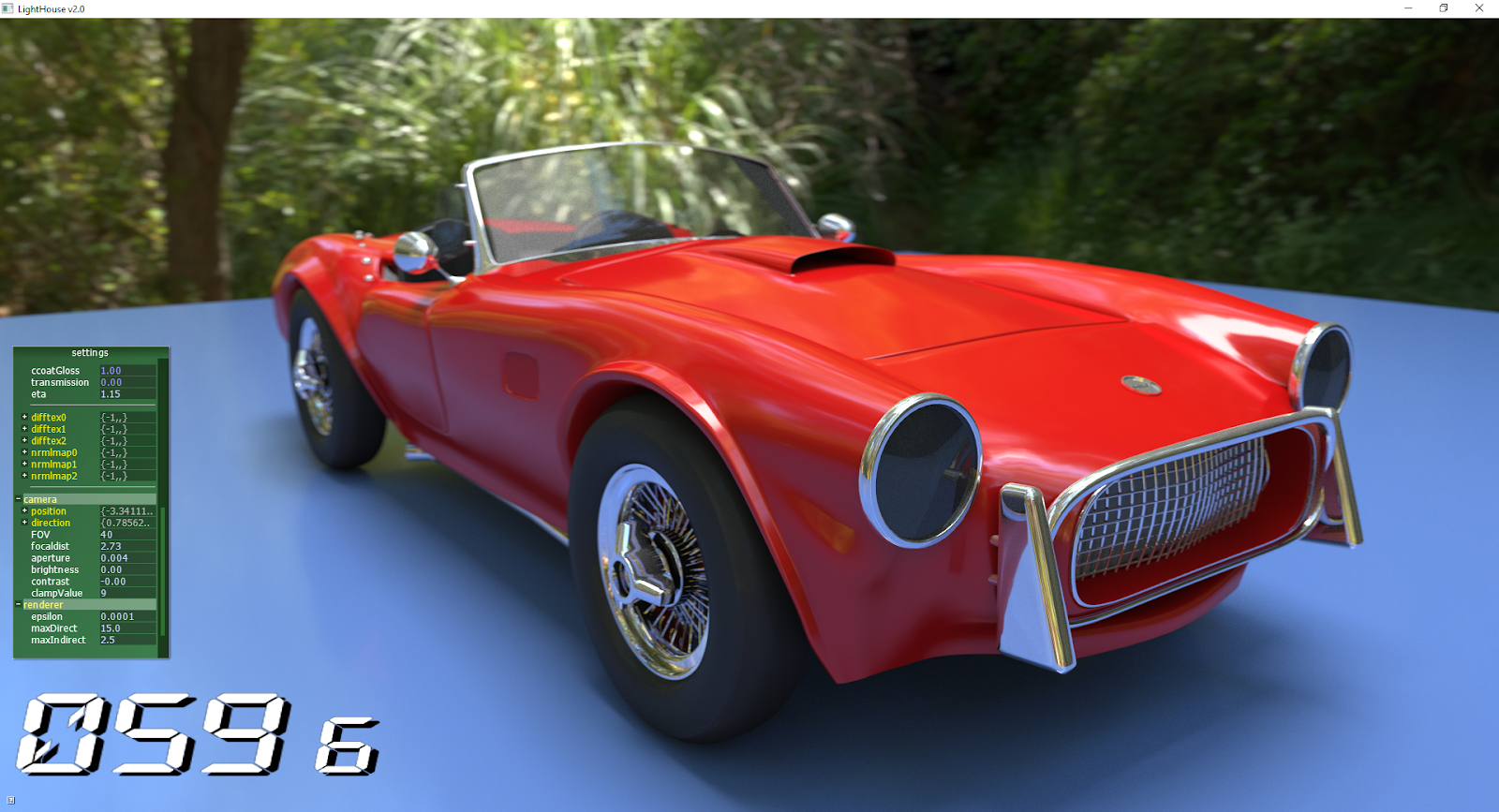jbikker / Lighthouse2
Projects that are alternatives of or similar to Lighthouse2
lighthouse2
Lighthouse 2 framework for real-time ray tracing
This is the public repo for Lighthouse 2, a rendering framework for real-time ray tracing / path tracing experiments. Lighthouse 2 uses a state-of-the-art wavefront / streaming ray tracing implementation to reach high ray througput on RTX hardware (using Optix 7.2) and pre-RTX hardware (using Optix 5 Prime) and soon on AMD hardware (using RadeonRays / OpenCL) and CPUs (using Embree). A software rasterizer is also included, mostly as an example of a minimal API implementation.
Quick pointers / Important advice:
- Building Lighthouse 2: Since February 2020, Lighthouse requires Visual Studio 2019. The CUDA-based cores require CUDA 11.1.
- Lighthouse 2 wiki: https://github.com/jbikker/lighthouse2/wiki (early stages)
- Trouble shooting page on the wiki: https://github.com/jbikker/lighthouse2/wiki/TroubleShooting
- Lighthouse 2 forum: https://ompf2.com/viewforum.php?f=18
- Follow the project on Twitter: @j_bikker
Lighthouse 2 uses a highly modular approach to ease the development of renderers.
The main layers are:
- The application layer, which implements application logic and handles user input;
- The RenderSystem, which handles scene I/O and host-side scene storage;
- The render cores, which implement low-level rendering functionality.
Render cores have a common interface and are supplied to the RenderSystem as dlls. The RenderSystem supplies the cores with scene data (meshes, instances, triangles, textures, materials, lights) and sparse updates to this data.
The Lighthouse 2 project has the following target audience:
Researchers
Lighthouse 2 is designed to be a high-performance starting point for novel algorithms involving real-time ray tracing. This may include new work on filtering, sampling, materials and lights. The provided ray tracers easily reach hundreds of millions of rays per second on NVidia and AMD GPUs. Combined with a generic GPGPU implementation, this enables a high level of freedom in the implementation of new code.
Educators
The Lighthouse 2 system implements all the boring things such as scene I/O, window management, user interfaces and access to ray tracing APIs such as Optix, RadeonRays and Embree; your students can get straight to the interesting bits. The architecture of Lighthouse 2 is carefully designed to be easily accessible. Very fast scene loading and carefully tuned project files ensure quick development cycles.
Industry
Lighthouse 2 is an R&D platform. It is however distributed with the Apache 2.0 license, which allows you to use the code in your own products. Experimental cores can be shared with the community in binary / closed form, and application development is separated from core development.
What it is not
The ray tracing infrastructure (with related scene management acceleration structure maintenance) should be close to optimal. The implemented estimators however (unidirectional path tracers without filtering and blue noise) are not, and neither is the shading model (Lambert + speculars). This may or may not change depending on the use cases encountered. This video shows what can be achieved with the platform: https://youtu.be/uEDTtu2ky3o .
Lighthouse 2 should compile out-of-the-box on Windows using Visual Studio 2019. For the CUDA/Optix based cores CUDA 11.1 is required:
https://developer.nvidia.com/cuda-downloads
Optix 5.x, 6.0 and 7.2 libraries are included in the Lighthouse 2 download and do not have to be downloaded separately.
For more information on Lighthouse 2 please visit: http://jacco.ompf2.com.
Credits
Lighthouse 2 was developed at the Utrecht University, The Netherlands.
Lighthouse 2 uses the following libraries:
Dear ImGui https://github.com/ocornut/imgui
FreeImage http://freeimage.sourceforge.net
Glad https://glad.dav1d.de
GLFW https://www.glfw.org
half 1.12 http://half.sourceforge.net
tinygltf https://github.com/syoyo/tinygltf
tinyobj https://github.com/syoyo/tinyobjloader
tinyxml2 https://github.com/leethomason/tinyxml2
zlib https://www.zlib.net
Contributions
- The Lighthouse2 Vulkan core (and sharedBSDF) was developed by Mèir Noordermeer (https://github.com/MeirBon).
- A Linux port by Marijn Suijten (https://github.com/MarijnS95) is being incorporated in the main repo.
- Animation code uses low-level optimizations by Alysha Bogaers and Naraenda Prasetya.
- OptixPrime_BDPT core by Guowei (Peter) Lu (https://github.com/pasu).
Previous Work
Lighthouse 2 implements research by (very incomplete):
- Marsaglia: random numbers
- Van Antwerpen, Laine, Karras, Aila: streaming path tracing
- Aila, Laine: persistent kernels
- Schied et al.: Spatiotemporal Variance-Guided Filtering (SVGF)
- Victor Voorhuis: improved SVGF for specular and glossy reprojection
- Eric Heitz: Blue noise distributions

